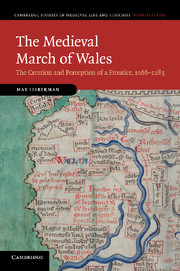Book contents
- Frontmatter
- Contents
- List of maps
- List of tables and illustration
- Preface
- List of abbreviations
- INTRODUCTION
- 1 A BORDER REGION?
- 2 THE MAKING OF A BORDER ARISTOCRACY
- 3 WARFARE AND DIPLOMACY
- 4 THE EXTENT AND NATURE OF THE MILITARY FRONTIER
- 5 THE MILITARIZATION OF SOCIETY
- 6 THE SHAPING OF ADMINISTRATIVE TERRITORIES
- 7 THE BORDER LORDSHIPS AND THE ENGLISH STATE
- CONCLUSION
- Select bibliography
- Index
Preface
Published online by Cambridge University Press: 06 July 2010
- Frontmatter
- Contents
- List of maps
- List of tables and illustration
- Preface
- List of abbreviations
- INTRODUCTION
- 1 A BORDER REGION?
- 2 THE MAKING OF A BORDER ARISTOCRACY
- 3 WARFARE AND DIPLOMACY
- 4 THE EXTENT AND NATURE OF THE MILITARY FRONTIER
- 5 THE MILITARIZATION OF SOCIETY
- 6 THE SHAPING OF ADMINISTRATIVE TERRITORIES
- 7 THE BORDER LORDSHIPS AND THE ENGLISH STATE
- CONCLUSION
- Select bibliography
- Index
Summary
This book sets out to solve a puzzle. It focuses on the period between the beginning of the Norman conquest of England (1066) and the English conquest of Wales (1283). This was when Norman and English knights and barons, having established themselves in England, encroached upon Welsh territory. It was also when the phrase ‘the March of Wales’ (Marchia Wallie) came to be widely used. However, that phrase appears not, at first, to have referred to the territories conquered in Wales (the territories known as the ‘Marcher lordships’ to modern-day historians of medieval Britain). Rather, the first ‘March of Wales’ seems to have been the Welsh border of the English county of Shropshire. It was only after a century and a half, from c. 1300, that all ‘Marcher lordships’, even those in south Wales, were normally included within the medieval March of Wales, the region known to contemporaries as Marchia Wallie.
This puzzle, along with some of the many others posed by the medieval March of Wales, has intrigued me for a number of years now. During that time I have benefited enormously from the help of others. I am very pleased to have the opportunity to record my thanks to them. This book is based on my Oxford DPhil. thesis, which was examined by Professor Thomas Charles-Edwards and Professor Huw Pryce. I am grateful to both for making my viva such a constructive occasion.
- Type
- Chapter
- Information
- The Medieval March of WalesThe Creation and Perception of a Frontier, 1066–1283, pp. xi - xiiPublisher: Cambridge University PressPrint publication year: 2010
- 1
- Cited by

